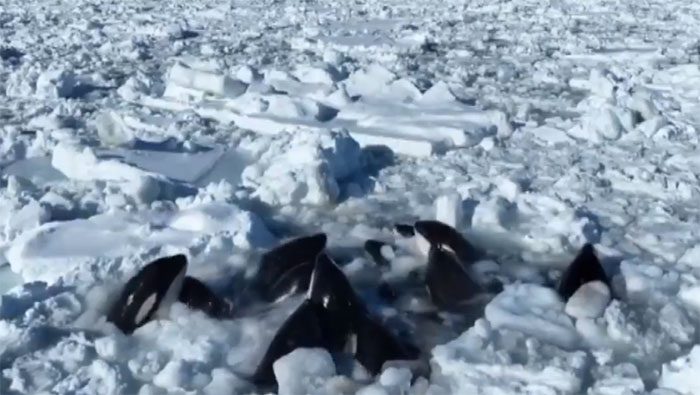Approximately 10 orcas are trapped amidst thick ice, several of them young, struggling to lift their heads above water to breathe.
A pod of orcas trapped in sea ice off the coast of Hokkaido. (Video: X/NHK).
Footage aired by Japan’s NHK on February 6 shows at least 10 orcas surfacing from a small opening in the water, surrounded by floating ice, about 1km from the coast of Rausu town on the Shiretoko Peninsula in Hokkaido. The thick ice has made it impossible for the coast guard to rescue the pod. “We have no choice but to wait for the ice to melt and let them escape that way,” an official from Rausu town said.
Marine expert Seiichiro Tsuchiya captured images of the trapped orcas using a drone. He discovered them while conducting research on the local sea lion population.
“I saw about 13 orcas lifting their heads from a hole in the ice. They appeared to be struggling to breathe, and there seemed to be 3 or 4 young ones in the pod,” he said. While the largest marine mammals can remain underwater for extended periods, orcas typically dive for only a few minutes at a time.

Orcas in distress in the waters near Hokkaido.
The waters off the eastern coast of Hokkaido, northern Japan, are covered in floating ice every winter. The amount of ice has decreased in recent years due to rising sea temperatures caused by climate change. Authorities have reported that the lack of wind has caused the ice to remain nearly stationary this week.
This is not the first time orcas have faced trouble in the waters near Hokkaido. In 2005, several individuals died after becoming trapped in sea ice off Rausu, a popular whale-watching spot in the summer.
Orca (Orcinus orca) is a widely distributed marine predator found in oceans around the world, with adults weighing up to 6 tons and measuring between 7 to 10 meters in length. In the wild, they live and hunt in pods. Their diet is incredibly diverse, including fish, penguins, seals, sea lions, rays, squid, seabirds, and even whales and sharks.


















































